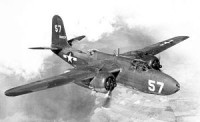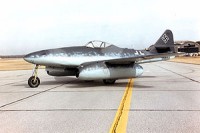By Dick Field ——Bio and Archives--March 16, 2010
Canadian News, Politics | CFP Comments | Reader Friendly | Subscribe | Email Us
 The planes that came over us had always been Boston bombers, a plane with large twin radial (air-cooled) engines, a distinctive upswept tail and all silver in colour. (see illustration on the left and note big engines and upswept tail). As we stood there talking, we saw these planes coming straight towards us from Germany, six of them, in formation. “Look here come the Bostons again,” someone said.
We all watched as they came closer and closer. Suddenly I knew something was amiss. The planes looked too black. They were flying even lower than usual. There was no upswept tail and they were coming in faster than any plane we had ever seen.
“They’re Krauts!” I yelled and dove for a slit trench about five feet away, the other guys piling in close behind. As we looked up we couldn’t believe our eyes or ears because these planes screamed across our gun position at enormous speeds and ‘no propellers!’ The noise was deafening. They were jet propelled airplanes! I had heard of them but had never seen one, none of us had.
First they circled the gun position, so we knew right away we were the target, and then they started to whistle and thunder straight at us, one after the other, crisscrossing from different directions at about 200 feet while dropping bombs. Fortunately for us they were small bombs called “Butterfly” bombs. These bombs had a cover that opened up as they dropped and looked like a butterfly. When they hit, they only made a hand-sized scoop in the ground. They were designed to kill troops above the ground with shrapnel (metal parts and probably balls of steel). Fortunately we had some cover close by, others were not so fortunate.
The planes that came over us had always been Boston bombers, a plane with large twin radial (air-cooled) engines, a distinctive upswept tail and all silver in colour. (see illustration on the left and note big engines and upswept tail). As we stood there talking, we saw these planes coming straight towards us from Germany, six of them, in formation. “Look here come the Bostons again,” someone said.
We all watched as they came closer and closer. Suddenly I knew something was amiss. The planes looked too black. They were flying even lower than usual. There was no upswept tail and they were coming in faster than any plane we had ever seen.
“They’re Krauts!” I yelled and dove for a slit trench about five feet away, the other guys piling in close behind. As we looked up we couldn’t believe our eyes or ears because these planes screamed across our gun position at enormous speeds and ‘no propellers!’ The noise was deafening. They were jet propelled airplanes! I had heard of them but had never seen one, none of us had.
First they circled the gun position, so we knew right away we were the target, and then they started to whistle and thunder straight at us, one after the other, crisscrossing from different directions at about 200 feet while dropping bombs. Fortunately for us they were small bombs called “Butterfly” bombs. These bombs had a cover that opened up as they dropped and looked like a butterfly. When they hit, they only made a hand-sized scoop in the ground. They were designed to kill troops above the ground with shrapnel (metal parts and probably balls of steel). Fortunately we had some cover close by, others were not so fortunate.
 I saw a Bren gun at the end of the slit trench and yelled at the guy close to it, “Get that gun going, see if you can hit the bastards!” He picked it up, got about three shots away when the gun jammed. It turned out the magazine had sand in it and the spring wasn’t able to force the bullets into the breach. Somebody hadn’t cleaned the weapon. We watched and prayed that none of the bombs would drop into our slit trench and we were lucky. The noise of the jets was almost unbearable.
The bombs made a racket too, but worse, on both sides of our gun position we had a Bofors 40 MM rapid fire anti-aircraft gun banging away at the jets and shooting right over our heads. Unfortunately, they weren’t even coming close to the jets.
It seemed like the raid went on for 20 minutes but it was probably half that time. As the last jet flew away we saw one of our shells explode under its wing and the wing rocked upward but he flew out of sight. So far as we could see none were shot down**
Later, I went over to speak to the crew of one of the anti-aircraft guns and asked them why they couldn’t hit the @%&@ Krauts. “Come up here (the gun sat up on a great big tripod) and I’ll show you,” the Sergeant-Major in charge said. So he showed me the sighting apparatus and it had settings for speeds up to 350 miles per hour but these planes were flying at nearly 500 miles per hour. “Just too damn fast” he said**
As I mentioned earlier, once the Germans knew your position and you were causing them a little grief, they came back at you. That night they came at us again with some very big guns. But that’s another story.
* The name Kraut comes from Sauer Kraut, the pickled cabbage that is a favourite German dish. As a matter of fact the German army diet was so different from ours that whenever we entered an abandoned German trench or a place recently occupied by somebody we could always tell if the Germans had been there and roughly how long ago by the smell. It always made me think of the Jack in the Beanstalk fairy tale where the Giant huffs and puffs and says, “Fee Fie Fo Fum, I smell the blood of an Englishman!” It was an odour something like a mixture of garlic, smoked sausage, sweat and stale black bread.
** This attack was one of the very first ground attacks by the first combat jet aircraft in the World. The German Messerschmitt.262 (see photo from Wikipedia). According to Colonel W.G. L. Nicholson, the official war historian of the Royal Regiment of Canadian Artillery (all the Canadian Artillery), we had three gunners killed and shot down two jets. I knew we had some casualties but I didn’t know
them and as to the jets shot down, that’s questionable. We didn’t see any go down, neither did the anti-aircraft gunners.
I saw a Bren gun at the end of the slit trench and yelled at the guy close to it, “Get that gun going, see if you can hit the bastards!” He picked it up, got about three shots away when the gun jammed. It turned out the magazine had sand in it and the spring wasn’t able to force the bullets into the breach. Somebody hadn’t cleaned the weapon. We watched and prayed that none of the bombs would drop into our slit trench and we were lucky. The noise of the jets was almost unbearable.
The bombs made a racket too, but worse, on both sides of our gun position we had a Bofors 40 MM rapid fire anti-aircraft gun banging away at the jets and shooting right over our heads. Unfortunately, they weren’t even coming close to the jets.
It seemed like the raid went on for 20 minutes but it was probably half that time. As the last jet flew away we saw one of our shells explode under its wing and the wing rocked upward but he flew out of sight. So far as we could see none were shot down**
Later, I went over to speak to the crew of one of the anti-aircraft guns and asked them why they couldn’t hit the @%&@ Krauts. “Come up here (the gun sat up on a great big tripod) and I’ll show you,” the Sergeant-Major in charge said. So he showed me the sighting apparatus and it had settings for speeds up to 350 miles per hour but these planes were flying at nearly 500 miles per hour. “Just too damn fast” he said**
As I mentioned earlier, once the Germans knew your position and you were causing them a little grief, they came back at you. That night they came at us again with some very big guns. But that’s another story.
* The name Kraut comes from Sauer Kraut, the pickled cabbage that is a favourite German dish. As a matter of fact the German army diet was so different from ours that whenever we entered an abandoned German trench or a place recently occupied by somebody we could always tell if the Germans had been there and roughly how long ago by the smell. It always made me think of the Jack in the Beanstalk fairy tale where the Giant huffs and puffs and says, “Fee Fie Fo Fum, I smell the blood of an Englishman!” It was an odour something like a mixture of garlic, smoked sausage, sweat and stale black bread.
** This attack was one of the very first ground attacks by the first combat jet aircraft in the World. The German Messerschmitt.262 (see photo from Wikipedia). According to Colonel W.G. L. Nicholson, the official war historian of the Royal Regiment of Canadian Artillery (all the Canadian Artillery), we had three gunners killed and shot down two jets. I knew we had some casualties but I didn’t know
them and as to the jets shot down, that’s questionable. We didn’t see any go down, neither did the anti-aircraft gunners.View Comments
Dick Field, editor of Blanco’s Blog, is the former editor of the Voice of Canadian Committees and the Montgomery Tavern Society, Dick Field is a World War II veteran, who served in combat with the Royal Canadian Artillery, Second Division, 4th Field Regiment in Belgium, Holland and Germany as a 19-year-old gunner and forward observation signaller working with the infantry. Field also spent six months in the occupation army in Northern Germany and after the war became a commissioned officer in the Armoured Corps, spending a further six years in the Reserves.